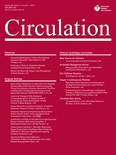Janoušek J, van Geldorp IE, Krupičková S, Rosenthal E, Nugent K, Tomaske M, Früh A, Elders J, Hiippala A, Kerst G, Gebauer RA, Kubuš P, Frias P, Gabbarini F, Clur SA, Nagel B, Ganame J, Papagiannis J, Marek J, Tisma-Dupanovic S, Tsao S, Nürnberg JH, Wren C, Friedberg M, de Guillebon M, Volaufova J, Prinzen FW, Delhaas T; Working Group for Cardiac Dysrhythmias and Electrophysiology of the Association for European Pediatric Cardiology. Circulation. 2013 Feb 5;127(5):613–23. doi: 10.1161/CIRCULATIONAHA.112.115428. Epub 2012 Dec 30. IF: 15.202

Children's Heart Center
Abstract
BACKGROUND: We evaluated the effects of the site of ventricular pacing on left ventricular (LV) synchrony and function in children requiring permanent pacing. METHODS AND RESULTS: One hundred seventy-eight children (aged <18 years) from 21 centers with atrioventricular block and a structurally normal heart undergoing permanent pacing were studied cross-sectionally. Median age at evaluation was 11.2 (interquartile range, 6.3–15.0) years. Median pacing duration was 5.4 (interquartile range, 3.1–8.8) years. Pacing sites were the free wall of the right ventricular (RV) outflow tract (n=8), lateral RV (n=44), RV apex (n=61), RV septum (n=29), LV apex (n=12), LV midlateral wall (n=17), and LV base (n=7). LV synchrony, pump function, and contraction efficiency were significantly affected by pacing site and were superior in children paced at the LV apex/LV midlateral wall. LV dyssynchrony correlated inversely with LV ejection fraction (R=0.80, P=0.031). Pacing from the RV outflow tract/lateral RV predicted significantly decreased LV function (LV ejection fraction <45%; odds ratio, 10.72; confidence interval, 2.07–55.60; P=0.005) whereas LV apex/LV midlateral wall pacing was associated with preserved LV function (LV ejection fraction ≥55%; odds ratio, 8.26; confidence interval, 1.46–47.62; P=0.018). Presence of maternal autoantibodies, gender, age at implantation, duration of pacing, DDD mode, and QRS duration had no significant impact on LV ejection fraction. CONCLUSIONS: The site of ventricular pacing has a major impact on LV mechanical synchrony, efficiency, and pump function in children who require lifelong pacing. Of the sites studied, LV apex/LV midlateral wall pacing has the greatest potential to prevent pacing-induced reduction of cardiac pump function.
-Barbora Beňová-